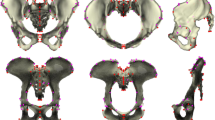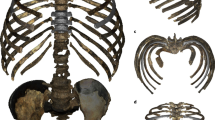Abstract
The Middle Pleistocene site of Sima de los Huesos in Sierra de Atapuerca, Spain, has yielded around 2,500 fossils from at least 33different hominid individuals1. These have been dated at more than 200,000 years ago2,3,4 and have been classified as ancestors of Neanderthals5,6. An almost complete human male pelvis (labelled Pelvis 1) has been found, which we associate with two fragmentary femora. Pelvis 1 is robust and very broad with a very long superior pubic ramus, marked iliac flare, and a long femoral neck. This pattern is probably the primitive condition from which modern humans departed. A modern human newborn would pass through the birth canal of Pelvis 1 and this would be even larger in a female individual. We estimate the body mass of this individual at 95 kg or more. Using the cranial capacities of three specimens from Sima de los Huesos, the encephalization quotients are substantially smaller than in Neanderthals and modern humans.
This is a preview of subscription content, access via your institution
Access options
Subscribe to this journal
Receive 51 print issues and online access
$199.00 per year
only $3.90 per issue
Buy this article
- Purchase on Springer Link
- Instant access to full article PDF
Prices may be subject to local taxes which are calculated during checkout



Similar content being viewed by others
References
Arsuaga, J. L. et al. Sima de los Huesos (Sierra de Atapuerca, Spain). The site. J. Hum. Evol. 33, 109–127 (1997).
García, N., Arsuaga, J. L. & Torres, T. The carnivore remains from the Sima de los Huesos Middle Pleistocene site (Sierra de Atapuerca, Spain). J. Hum. Evol. 33, 155–174 (1997).
Bischoff, J. L. et al. Geology and preliminary dating of the hominid-bearing sedimentary fill of the Sima de los Huesos Chamber, Cueva Mayor of the Sierra de Atapuerca, Burgos, Spain. J. Hum. Evol. 33, 129–154 (1997).
Cuenca-Bescós, G., Laplana Conesa, C., Canudo, J. I. & Arsuaga, J. L. Small mammals from Sima de los Huesos. J. Hum. Evol. 33, 175–190 (1997).
Arsuaga, J. L., Martínez, I., Gracia, A., Carretero, J. M. & Carbonell, E. Three new human skulls from the Sima de los Huesos Middle Pleistocene site in Sierra de Atapuerca, Spain. Nature 362, 534–537 (1993).
Arsuaga, J. L., Martínez, I., Gracia, A. & Lorenzo, C. The Sima de los Huesos crania (Sierra de Atapuerca, Spain). A comparative study. J. Hum. Evol. 33, 219–281 (1997).
Rak, Y. In Le squelette Moustérien de Kébara 2. (eds Bar Yosef, O. & Vandermeersch, B.) 147–156 (CNRS, Paris, (1991).
Rosenberg, K. In Neandertals and Modern Humans in Western Asia (eds Akazawa, T., Aoki, K. & Bar-Yosef, O.) 367–379 (Plenum, New York, (1998).
Arsuaga, J. L. & Carretero, J. M. Multivariate analysis of the sexual dimorphism of the hip bone in a modern population and in early hominids. Am. J. Phys. Anthropol. 93, 241–257 (1994).
Feldesman, M. R., Kleckner, J. G. & Lundy, J. K. Femur/stature ratio and estimates of stature in mid- and late-Pleistocene fossil hominids. Am. J. Phys. Anthropol. 83, 359–372 (1990).
Trotter, M. & Gleser, G. C. Estimation of stature from long bones of American Whites and Negroes. Am. J. Phys. Anthropol. 10, 463–514 (1952).
Ruff, C. B., Trinkaus, E. & Holliday, T. W. Body mass and encephalization in Pleistocene Homo. Nature 387, 173–176 (1997).
Kappelman, J. They might be giants. Nature 387, 126–127 (1997).
Arsuaga, J. L. et al. Size variation in Middle Pleistocene humans. Science 277, 1086–1088 (1997).
Lorenzo, C., Carretero, J. M., Arsuaga, J. L., Gracia, A. & Martínez, I. Intrapopulational body size variation and cranial capacity variation in Middle Pleistocene humans. The Sima de los Huesos sample (Sierra de Atapuerca, Spain). Am. J. Phys. Anthropol. 106, 19–33 (1998).
Ruff, C. B. & Walker, A. In The Nariokotome Homo erectus Skeleton (eds Walker, A. & Leakey, R. E. F.) 234–265 (Springer, Berlin, (1993).
Rak, Y. In Species, Species Concepts, and Primate Evolution (eds Kimbel, W. H. & Martin, L. B.) 523–536 (Plenum, New York, (1993).
Abitbol, M. M. Birth and Human Evolution (Bergin & Garvey, London, (1996).
Walrath, D. E. & Glantz, M. M. Sexual dimorphism in the pelvic midplane and its relationship to Neandertal reproductive patterns. Am. J. Phys. Anthropol. 100, 89–100 (1996).
Tague, R. G. Commonalities in dimorphism and variability in the anthropoid pelvis, with implications for the fossil record. J. Hum. Evol. 21, 153–176 (1991).
Trinkaus, E. Neanderthal mortality patterns. J. Archaeol. Sci. 22, 121–142 (1995).
Serra, J. A. Apelve nos portugueses. Morfologia da pelve no homen. Contrib. Estudo Anthropol. Port. 15, 1–173 (1998).
Tague, R. G. Sexual dimorphism in the human bony pelvis, with a consideration of the Neandertal pelvis from Kebara Cave, Israel. Am. J. Phys. Anthropol. 88, 1–21 (1992).
Acknowledgements
We thank G. Manzi, Y. Rak and I. Hershkovitz for comments on the manuscript, and J. Trueba for providing the photographs. C.L. received a grant from Ayuntamiento de Madrid in the Residencia de Estudiantes. This research is partly funded by the Junta de Castilla y León, the Dirección General de Enseñanza Superior of Spain (PB93-0066-C03), Comunidad de Madrid (CAM 06/0037/1997) and Unidades Asociadas (CSIC).
Author information
Authors and Affiliations
Corresponding author
Rights and permissions
About this article
Cite this article
Arsuaga, JL., Lorenzo, C., Carretero, JM. et al. A complete human pelvis from the Middle Pleistocene of Spain. Nature 399, 255–258 (1999). https://doi.org/10.1038/20430
Received:
Accepted:
Issue Date:
DOI: https://doi.org/10.1038/20430
This article is cited by
-
Variation in human 3D trunk shape and its functional implications in hominin evolution
Scientific Reports (2022)
-
Rib cage anatomy in Homo erectus suggests a recent evolutionary origin of modern human body shape
Nature Ecology & Evolution (2020)
-
3D virtual reconstruction of the Kebara 2 Neandertal thorax
Nature Communications (2018)
-
Ribcage measurements indicate greater lung capacity in Neanderthals and Lower Pleistocene hominins compared to modern humans
Communications Biology (2018)
-
Estimating hominid life history: the critical interbirth interval
Population Ecology (2018)
Comments
By submitting a comment you agree to abide by our Terms and Community Guidelines. If you find something abusive or that does not comply with our terms or guidelines please flag it as inappropriate.



